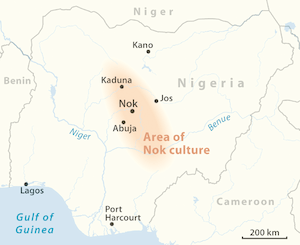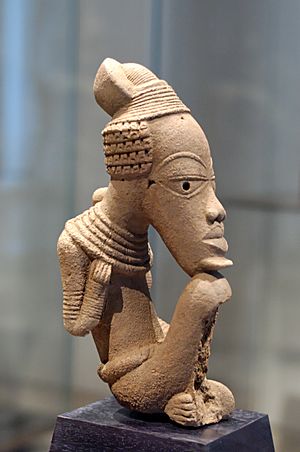Nok culture facts for kids
The Nok culture was an ancient civilization that lived in what is now Nigeria, in West Africa. It existed for a long time, from about 1000 BC to 300 CE. This means it lasted for over 1300 years! The Nok people are famous for being the first in sub-Saharan Africa to create amazing, life-sized sculptures out of Terracotta, which is a type of clay. They also used iron to make tools, which was very advanced for their time. Many experts believe the Nok culture had a very organized and developed social system for its era.
Contents
Discovering the Nok Culture
The first pieces of Nok culture were found by accident. In 1928, workers were digging for tin in a village called Nok, in central Nigeria. They found a small terracotta head. At first, people didn't realize how important this discovery was.
More Finds and Research
Later, in the 1940s, a British archaeologist named Bernard Fagg began to study the area. He found many more terracotta sculptures and tools. These discoveries helped experts understand that they had found evidence of a unique and ancient civilization. The culture was named "Nok" after the village where the first artifact was found.
Life and Art of the Nok People
The Nok people lived in northern and central Nigeria. They were skilled farmers and metalworkers. They lived in settlements and had a well-organized society.
Amazing Terracotta Sculptures
The most famous things left behind by the Nok culture are their terracotta sculptures. These are clay figures that were baked until they were hard. They often show human heads and figures, as well as animals.
- The sculptures are very detailed and artistic.
- They often have unique hairstyles and jewelry.
- Some figures are almost life-sized, which was a big achievement for their time.
- Experts believe these sculptures might have been used in religious ceremonies or to honor important people.
Early Use of Iron
The Nok culture was one of the first groups in West Africa to use iron. They learned how to melt iron ore and shape it into tools. This process is called smelting and forging.
- They made iron tools for farming, like hoes.
- They also made weapons and other useful items.
- Using iron was a big step forward because iron tools were much stronger and more durable than stone tools.
- The earliest evidence of iron use by the Nok people dates back to at least 550 BC, and possibly even earlier.
What Happened to the Nok Culture?
The Nok culture mysteriously disappeared around 300 CE. We don't know exactly why they vanished.
- Some theories suggest that climate change might have made it difficult to farm.
- Others think that diseases or changes in their environment could have played a role.
- It's also possible that they gradually blended into other groups.
Legacy of the Nok People
Even though the Nok culture disappeared, their influence might have lived on. Some historians believe that the Nok culture eventually evolved into the Yoruba people, who are a large ethnic group in Nigeria today. The artistic traditions and skills of the Nok people left a lasting mark on the history of African art and technology.
See also
 In Spanish: Cultura Nok para niños
In Spanish: Cultura Nok para niños



